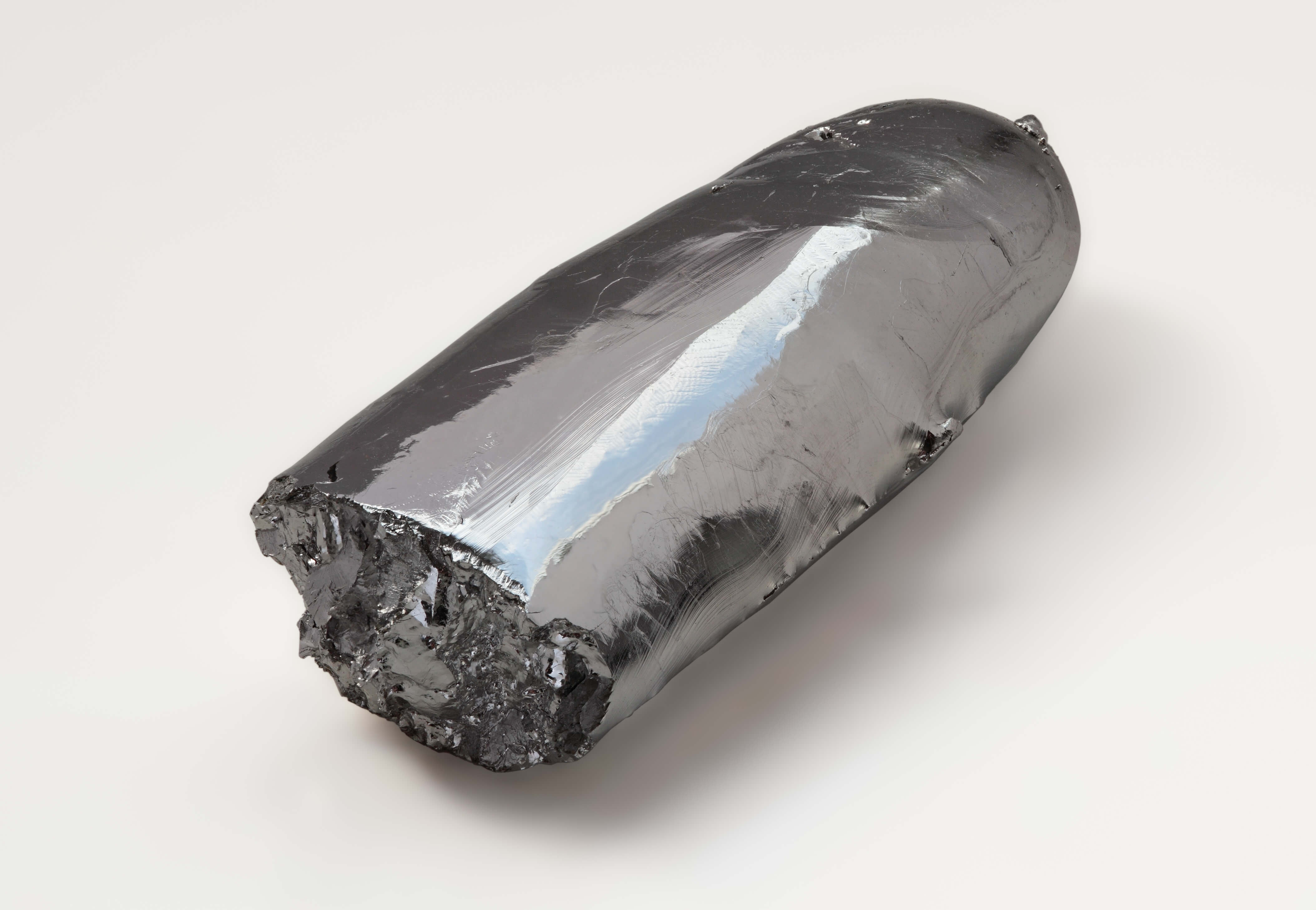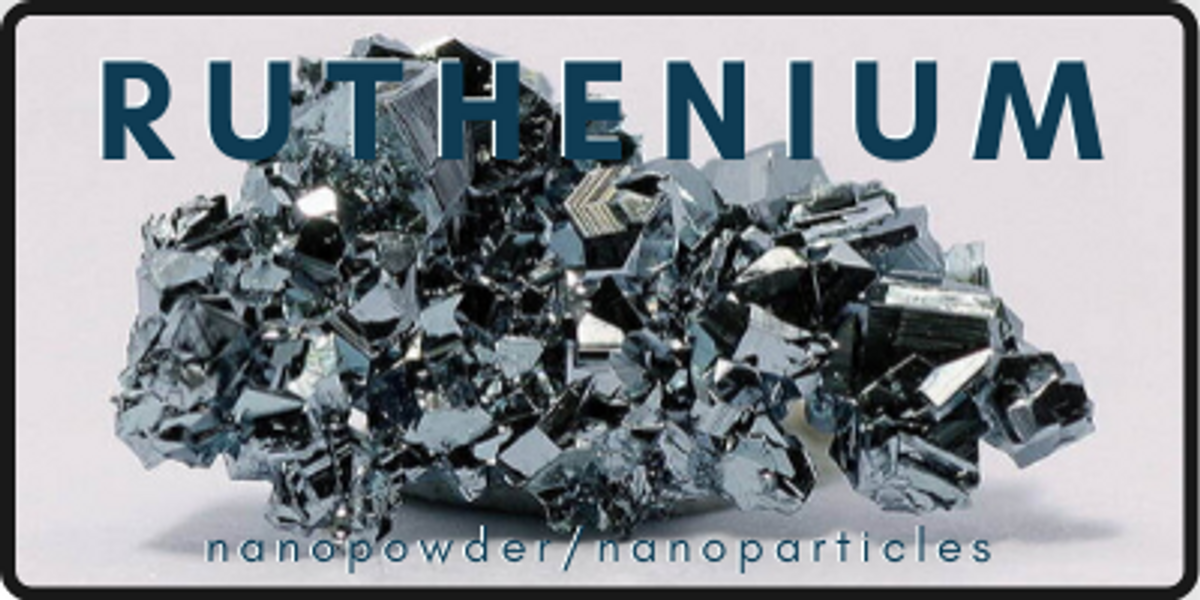Ruthenium Nanopowder/Nanoparticle
Ruthenium nanoparticles/nanopowder are easily reducible plate-like fine metallic particles that crystallize into a hexagonal compact structure. The anisotropic growth of ruthenium nanoparticles is possible in homogenous solutions due to the hexagonal structure that they adopt. Nevertheless, the majority of transition metals have a cubic crystalline structure and lack the anisotropic growth. Elemental ruthenium a rare silvery hard metal placed among the transition metals of platinum group. Ruthenium is extracted from platinum ores through purifying osmiridium mineral 1. Considering its physical and chemical properties, Ruthenium belongs the platinum metal group together with Rh, Pd, Os, Ir and Pt. As a 4d transitional metal, ruthenium shows considerable catalytic behavior. The melting and boiling points of ruthenium are 2334˚C and 4150˚C, respectively. It maintains its brightness and paramagnetic property at room temperature due its unreactive nature at this condition. However, ruthenium engages in reaction with oxygen and is oxidized to ruthenium oxide (RuO2) at the higher temperature of 800˚C. Moreover, ruthenium reacts with halogen group at higher temperatures but can’t be dissolved in acids. On the contrary, ruthenium forms ruthenate cation with bases and dissolves in them 2.
Ruthenium Nanoparticles/Nanopowder Properties

Ruthenium is originally a strong catalytic agent that serves in many electrocatalytic and heterogenous reactions. As ruthenium is obtained in the nanoscales, its catalytic behavior\property goes beyond the imagination as a highly active system with particle sized ranging from 2 to 60nm. The catalytic behavior of ruthenium nanoparticles appears to depend on the size with the most favorable kinetic constant of –1.52 per minute which is far better than other noble metals that have catalytic applications. Ruthenium nanoparticles have emerged as highly efficient catalytic performance at lower temperatures with an appropriate recyclability in redox reactions such as those of azo dyes and nitroaromatic compounds. The previous knowledge of modern catalytic systems has provided an extensive view concerning ruthenium nanoparticle/nanopowder synthesis with the most favorable size to achieve the best catalytic performance. In the case of an in-situ monitoring of the kinetics and mechanism of heterogenous reactions, nanocatalysts, especially ruthenium nanoparticles, rise to exhibit superior catalytic activities. There have been great efforts in order to regulate the morphology of nanocatalysts to reach the highest catalytic efficiency. There is a fact that less accessible metal surfaces and poisonous nature of metals are the main causes to lower the catalytic behavior, whereas in nanoscales, these problems are overcome. Therefore, the size and morphology of Ru-based nanocrystals and nanoparticles strongly determine the selectivity and activity of ruthenium nanocatalysts 3.
Synthesis of Ruthenium Nanoparticles/Nanopowder
Several synthesis methods have been suggested to obtain ruthenium nanoparticles/nanopowder. In a size controllable method, polyvinylpyrrolidone (50mM) is dissolved in n-propanol (10mL). Later, 500mL RuCl3 nH2O (100mM) is added the previously prepared solution while stirring at 30˚C. The pH of the solution is adjusted to be 3.5. Next, a color change from the dark red to light yellow with a consecutive dark brown hue is observed. The solution is left for 10 hours and a dark brown homogenous transparent colloidal solution containing ruthenium nanoparticles is achieved. The final step includes the addition of acetone (3mL) to 1mL solution of ruthenium nanoparticle/nanopowder, agitation for two minutes and centrifugation of the mixture to separate the resulting crystalline precipitates 3. In another method, ruthenium nanoparticles/nanopowder are prepared through reducing RuCl3 in a liquid polyol with particle sizes between 1 and 6nm. The particle size in this range can be achieved by choosing a proper temperature with optimized concentration of acetate ion 4. There is also a green synthesis method of ruthenium nanoparticles which includes using leaf extracts of rosy periwinkle, sago palm, fishtail fern and holy basil plants in methanol 5. Another study has introduced environmentally-friendly method of ruthenium nanoparticle/nanopowder synthesis which uses very little amount of solvents 6.
Read Also About Germanium Powder
Ruthenium Nanoparticles/Nanopowder Application
Ruthenium nanoparticles/nanopowder have broad applications in polymer membranes, plastics, coating, textile and nanowires, synthesis of diesel fuels, hydrogenation, methanol fuel cells, magnetism, azo dye degradation, antibacterial use, organic pollution removal, electronic, optics, electrochemical capacitors hardening agent for alloys and, etc. Ruthenium nanoparticles in particular, show antibacterial performance against gram-negative and gram-positive bacteria 7.
As the inherent property from the metallic and elemental form, ruthenium nanoparticles/ nanopowder have a wide range of catalytic applications. It could be claimed that ruthenium is the most important metal among the noble metals regarding its strong catalytic behavior. Ammonia synthesis, oxidation of alcohols and amines, hydrogenation of unsaturated bonds, electro-oxidization of methanol, Fischer–Tropsch synthesis, carbon-carbon cross-coupling reactions are among the most common catalytic applications of ruthenium nanoparticles/ nanopowder.
References
1. Ivry, E., Ben-Asuly, A., Goldberg, I. & Lemcoff, N. G. Amino acids as chiral anionic ligands for ruthenium based asymmetric olefin metathesis. Chem. Commun. 51, 3870–3873 (2015).
2. Fajardo, S. et al. We are IntechOpen , the world ’ s leading publisher of Open Access books Built by scientists , for scientists TOP 1 %. Intech i, 13 (2016).
3. Zhao, Y., Luo, Y., Yang, X., Yang, Y. & Song, Q. Tunable preparation of ruthenium nanoparticles with superior size-dependent catalytic hydrogenation properties. J. Hazard. Mater. 332, 124–131 (2017).
4. Viau, G. et al. Ruthenium nanoparticles: Size, shape, and self-assemblies. Chem. Mater. 15, 486–494 (2003).
5. Gupta, P. K., Ranganath, K. V. S., Dubey, N. K. & Mishra, L. Green synthesis , characterization and biological activity of synthesized ruthenium nanoparticles using fishtail fern , sago palm , rosy periwinkle and holy basil. 117, (2019).
6. García-Peña, N. G. et al. Solventless synthesis of ruthenium nanoparticles. Appl. Surf. Sci. 340, 25–34 (2015).
7. Gopinath, K. & Karthika, V. Antibacterial activity of ruthenium nanoparticles synthesized using Gloriosa superba L . leaf extract. 4–9 (2014). doi:10.1007/s40097-014-0083-4
Recent Posts
-
What is the Difference Between 7075 and 6061 Aluminum Alloy?
When comparing 7075 aluminum alloy to 6061 aluminum alloy, it's essential to understand their disti …5th Apr 2024 -
Iron-Air Batteries: The Ultimate Guide
Iron-air batteries represent a significant breakthrough in energy storage technology, offering a sus …29th Mar 2024 -
Discovering the Power of 2D Materials
In material science, the discovery of two-dimensional (2D) materials represents a transformative de …22nd Mar 2024






